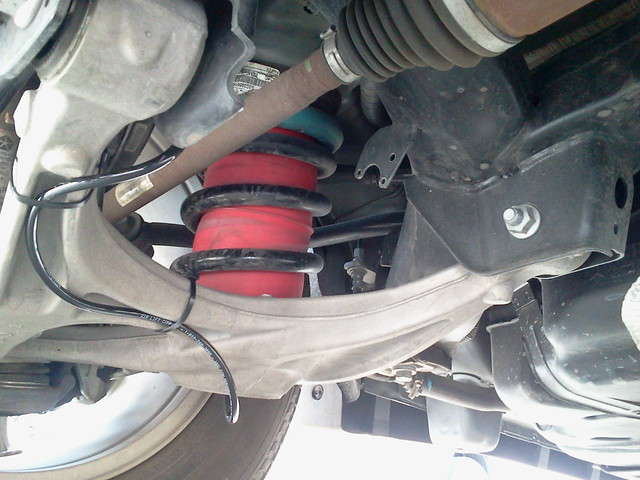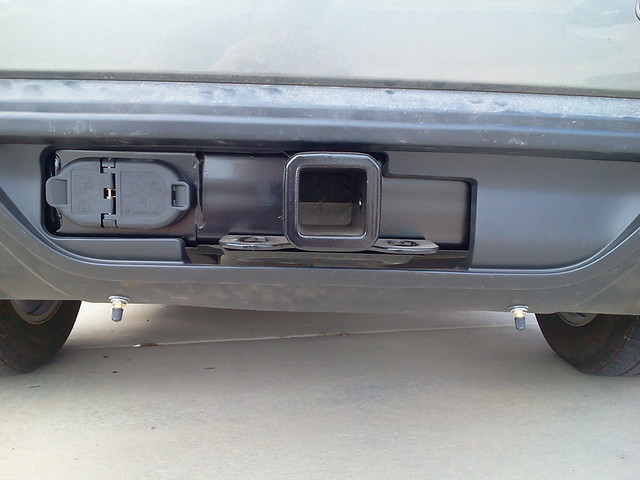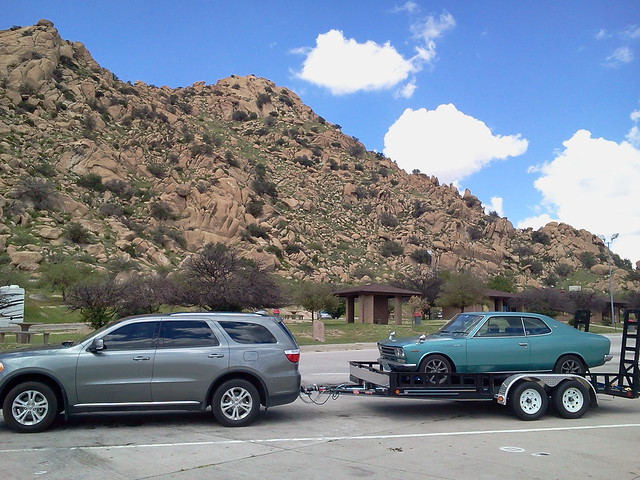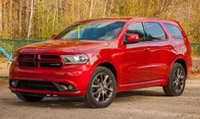Anyone use airbag spring helpers?
#11
I've got the Airlift ones on mine. I use it with the "self leveling" shocks. Helps a lot I feel. But I did little towing before having them. The rear of the Durango always felt very bouncy to me and wanted to get it better. Even with the airlift helpers the rear sags a bit from how it sits without the trailer and after driving. Here's a pic of it installed on mine:

And here's were I put the inflation valves:

Here's a pic of how the D was sitting at one of the stops on a trip:

This is when the 'self leveling' shocks are in their position from the load. I think the overall issue isn'y so much that the rear shocks sag, but that the front (non-self leveling) shocks tend to lift from the tongue load. I say that since the front of the Durango doesn't tend to sit up that high when I have no trailer.

And here's were I put the inflation valves:

Here's a pic of how the D was sitting at one of the stops on a trip:

This is when the 'self leveling' shocks are in their position from the load. I think the overall issue isn'y so much that the rear shocks sag, but that the front (non-self leveling) shocks tend to lift from the tongue load. I say that since the front of the Durango doesn't tend to sit up that high when I have no trailer.
#12
FYI, I had the Airlift 60824 air springs installed before starting an 11,700-mile trip around the US last summer. I kept them inflated to 35 psi and they definitely made a difference. My mechanic recommended joining the tubes to a single inflation valve. It makes inflation easier and they're always balanced. A single valve may not be best if you carry very heavy lopsided loads and need to have a different pressure on each side, but it's fine for towing.
They didn't eliminate the trailer sway completely but they kept the front wheels firmly planted so I never felt like it was out of control. One possible contributing factor to the swaying that I found is that the nose of the trailer is a little high, so I plan to lower the hitch before my next trip.
They didn't eliminate the trailer sway completely but they kept the front wheels firmly planted so I never felt like it was out of control. One possible contributing factor to the swaying that I found is that the nose of the trailer is a little high, so I plan to lower the hitch before my next trip.
#13
They didn't eliminate the trailer sway completely but they kept the front wheels firmly planted so I never felt like it was out of control. One possible contributing factor to the swaying that I found is that the nose of the trailer is a little high, so I plan to lower the hitch before my next trip.
-Rod
#14
i would be wary of having the two air springs on the same valve for one simple reason, body roll in corners, if the valves are linked without a check valve to stop air from flowing between the bags you can roll in a corner and as one spring shrinks the other will grow a proportional amount based on airflow. At the very least this would result in a different spring rate while cornering than while traveling straight and at the worst i could easily see it increasing body roll.
You do what you want, this is just an engineering perspective.
You do what you want, this is just an engineering perspective.
#15
When I had a Buick Roadmaster with air adjustable shocks, the system was set up so that there was one line from the compressor going to the driver's side shock and a 2nd line going from the driver's side shock to the passenger side shock, however, to minimize air shifting from one shock to another, the line between the shocks was a much smaller ID. If I remember correctly, the line between the shocks was like 0.031" ID, while the line from the compressor to the shock was like 0.090" ID. When GM discontinued making the two different shocks, the replaced air shocks were the same type, but, I installed a "T" maintaining the line to the driver's side shock at 0.090" ID and to the passenger's side shock at 0.031" ID. I guess you could do the same when using one valve for both air bags - use two different ID lines to minimize air transfer between them when cornering.
#16
Air Lift sells multiple versions of controllers and compressor systems that inflate both shocks from a single line, no indication of a check valve in those kits. Besides, a check valve versus an electronically controlled valve would prevent the user from being able to deflate the bags which would be an even bigger safety hazard as folks would be driving with inflated bags and no extra load.
I suspect if having a single line for both was a serious concern, their legal department would require them to provide check valves and have some form of preventing the installer from just teeing the two bags together. Instead though, the kit includes a tee.
-Rod
I suspect if having a single line for both was a serious concern, their legal department would require them to provide check valves and have some form of preventing the installer from just teeing the two bags together. Instead though, the kit includes a tee.
-Rod
#17
Air Lift sells multiple versions of controllers and compressor systems that inflate both shocks from a single line, no indication of a check valve in those kits. Besides, a check valve versus an electronically controlled valve would prevent the user from being able to deflate the bags which would be an even bigger safety hazard as folks would be driving with inflated bags and no extra load.
I suspect if having a single line for both was a serious concern, their legal department would require them to provide check valves and have some form of preventing the installer from just teeing the two bags together. Instead though, the kit includes a tee.
-Rod
I suspect if having a single line for both was a serious concern, their legal department would require them to provide check valves and have some form of preventing the installer from just teeing the two bags together. Instead though, the kit includes a tee.
-Rod
Anyhow, the DD tow bar is mounted at the rear subframe. It would be better if they had a tow bar that distributed the load better over the rear wheels or even between the front and rear wheels - like 5th wheel trailers that are mounted on pick-up trucks beds.
Lifting the rear end up should help maintain the front end at its regular height. On the other hand, you could add a front end spoiler that would push the front end down and maintain better road contact (thus steering control) at speed - like the NASCAR cars have (well, maybe not to that extent).
#18
I've got the Airlift ones on mine. I use it with the "self leveling" shocks. Helps a lot I feel. But I did little towing before having them. The rear of the Durango always felt very bouncy to me and wanted to get it better. Even with the airlift helpers the rear sags a bit from how it sits without the trailer and after driving. Here's a pic of it installed on mine:

And here's were I put the inflation valves:

Here's a pic of how the D was sitting at one of the stops on a trip:

This is when the 'self leveling' shocks are in their position from the load. I think the overall issue isn'y so much that the rear shocks sag, but that the front (non-self leveling) shocks tend to lift from the tongue load. I say that since the front of the Durango doesn't tend to sit up that high when I have no trailer.

And here's were I put the inflation valves:

Here's a pic of how the D was sitting at one of the stops on a trip:

This is when the 'self leveling' shocks are in their position from the load. I think the overall issue isn'y so much that the rear shocks sag, but that the front (non-self leveling) shocks tend to lift from the tongue load. I say that since the front of the Durango doesn't tend to sit up that high when I have no trailer.
#19
Sorry, been out for a bit. The car is a 1970 Nissan Laurel I picked up from Japan, it's a project I hope to find time to pursue.
#20



